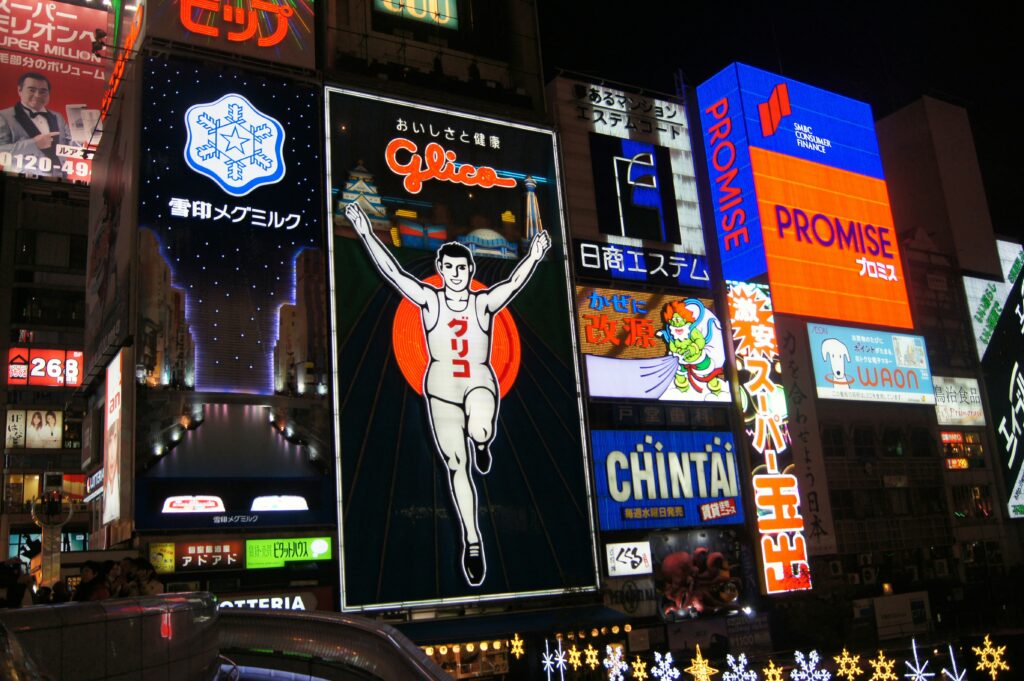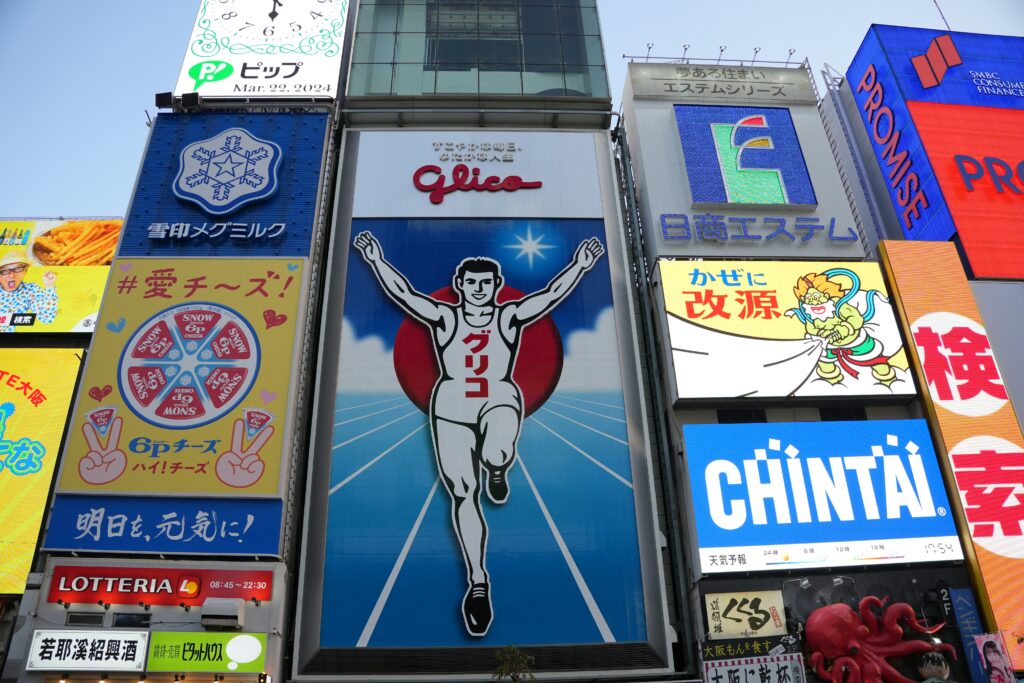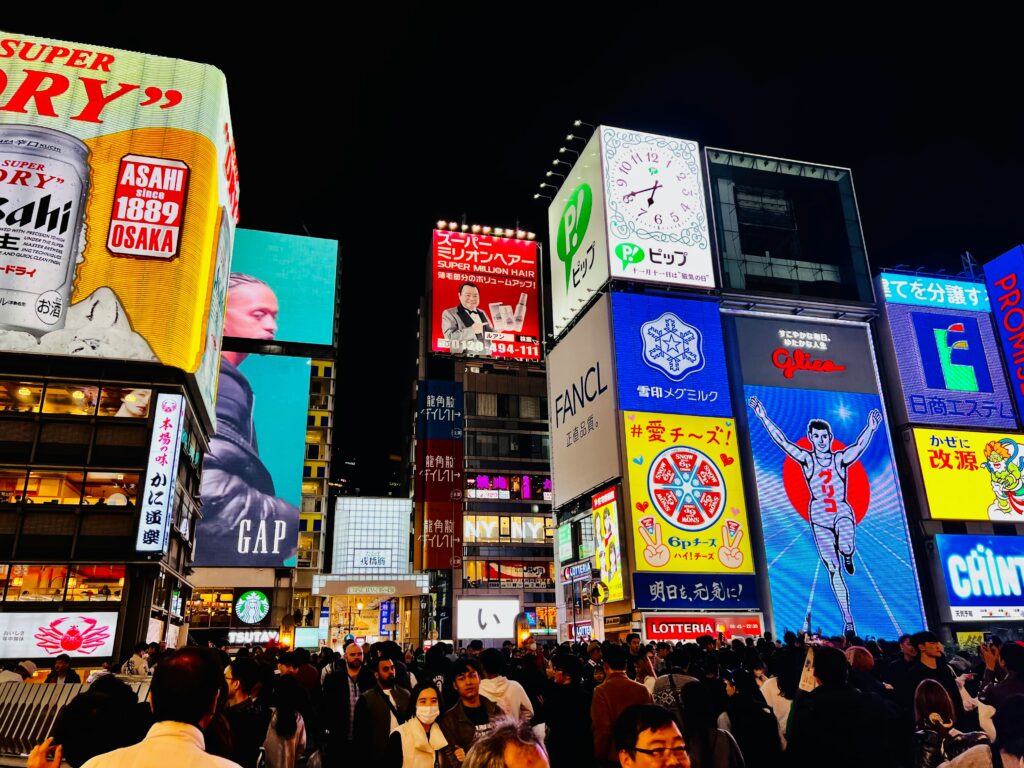
Whenever you visit Dotonbori in Osaka, you are sure to see the brightly shining Glico Man. These billboards are more than just advertisements; they continue to be loved by people as a symbol of Osaka.
In this article, we will introduce the history of the Glico sign and its charm in detail. If you are planning to visit Dotonbori, please check it out.
History of Glico Man
Birth of the first Glico Man
The first Glico Man appeared in 1935 and became a landmark in Dotonbori, Osaka. The sign was installed by the founder of Ezaki Glico(a Japanese confectionery company) to represent “healthy and enjoyable life.
The original sign was simple, using neon tubes, and caught the attention of visitors to Dotonbori. After several renewals, it took on its current form and now features a vivid LED presentation.
The male runner depicted on the Glico sign is not modeled on any particular real person. He is depicted as a character symbolizing a healthy and energetic image based on the “300 meters per grain” concept of Glico, a nutritional confectionery created by Ezaki Glico's founder, Toshikazu Ezaki.
The runner represents Glico's brand image of “health,” “vitality,” and “progress,” a symbol that has been familiar to people for many years. Therefore, the design is not modeled on any specific athlete or celebrity, but is only a symbolic character.
Evolution of Signs and Designs

(Quoted from the official website:https://www.glico.com/jp/health/contents/glicosign/)
The Glico mas has evolved with the times, having undergone six renewals over the years.
The change from the first to the second generation improved the posture and expression of the Glico man, giving it a more dynamic look; in the 1980s, the sign evolved into something more vivid and dynamic with the technological innovations in advertising. The latest billboards use environmentally friendly LED lighting to meet the needs of the times.
Why the Glico man became a symbol of Osaka

Relationship with Dotonbori
The Glico man is located in the center of Dotonbori, and together with the surrounding neon lights, it adds color to the nightscape of Osaka. Dotonbori itself is a famous downtown area of Osaka, and the Glico man standing in the center of the area was naturally accepted as a local symbol.
The sign blends in with the scenery of Dotonbori as a spot where tourists are sure to take pictures.
Why locals and tourists love it
For locals, the Glico man is part of their daily scenery and is specially illuminated during festivals and events. For tourists, it is also widely shared on social networking sites as a “must-see” spot for sightseeing in Osaka. Jumping under the sign to take a picture is a standard way to enjoy the place, and many people have created special memories at this location.
Attractive points of Glico man
Night lights and Grico man's attractions

At night, the Glico sign is brilliantly illuminated, and together with the surrounding neon lights, makes the night view of Dotonbori even more spectacular. The sign's runner-like effect gives the viewer a sense of energy and makes it ideal for taking pictures.
Especially from evening to night, many people enjoy taking commemorative photos with the lights in the background.
Popular as a photo spot
The Glico sign is a classic photo spot that always appears on Osaka's sightseeing posters and in guidebooks. Tourists are wont to strike a “Glico pose” in front of the sign, and the colors and presentation of the lights change with the seasons, making it a fresh experience no matter how many times you visit.
Q&A
Q: What was the earliest design of Glico signboards?
A: The first Glico sign was installed in 1935 and was simple, using neon tubes. The runner design as we see it today was carried over from the first generation, but in the early days the presentation was more modest than today.
Q: Why did the Glico sign become a symbol of Osaka?
A: Because the Glico sign was located in the center of Dotonbori, and its brilliant lights came to symbolize the night scene of Osaka. It is loved by the locals and is also a familiar “face” of Osaka for tourists.
Q: What are the features of the current Glico sign?
A: The current Glico signage uses LEDs and is designed to be environmentally friendly. They can be produced in a variety of ways and are sometimes specially illuminated for special events and holidays.
Summary(A must-see sigh of Gulico Man in Osaka,Japan!)
The Glico man is a symbol of Osaka and is familiar to many people along with the scenery of Dotonbori. since its first appearance in 1935, the sign has been renewed many times, each time incorporating the latest technology and design.
The nighttime illumination is particularly spectacular, providing visitors with an unforgettable experience. The Glico sign will continue to reflect the heart and soul of Osaka and will remain an attractive tourist attraction for many people.
ALSO CHECK
-

-
10 cheap and stylish hotels in Osaka 2025
(Source:Hotel androoms Osaka Hommachi>Guest rooms) Have you ever been to central city in western ...
続きを見る